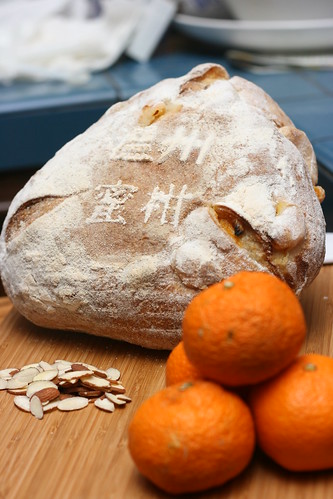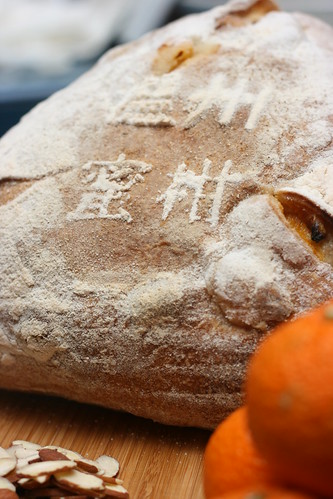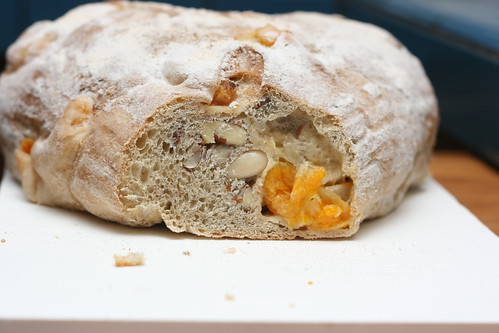In my continuing quest to stick any fruit I can into a loaf of bread, I wanted to try adding some type of citrus to a loaf of bread. Pears, strawberries, and bananas worked, so why not right? I figured that if I left individual sections whole and was very gentle when handling the dough, they wouldn't add too much excess moisture. That meant I needed to use a rather small citrus, and since I happened to have satsumas around they got the nod. I made from zest from them to put in the dough too, and used an orange olive oil so the bread itself would also carry a bit of the citrus flavor. Almonds seem to pair the best with citrus to me, so I used some slices almonds in the loaves. In the future I don't think I'll use sliced almonds, they don't distribute quite as evenly in the dough, live and learn!
Almond and Satsuma Bread
Makes: 2 medium, or 3 small loaves
Time: Day 1: Elaborate starter. Day 2: Mix final dough, fold dough shape, proof, and bake.
Ingredients:
| Ounces | Grams | Percent | |
| Starter | |||
| Bread Flour | 8 oz | 230 gm | 100 |
| Water | 5.25 oz | 150 gm | 67% |
| 66% Levain | 3 oz | 85 gm | 38% |
| Final Dough | |||
| Starter | 16.25 oz | 461 gm | 87.% |
| Bread Flour | 13.5 oz | 383 gm | 72.9% |
| Whole Rye Flour | 2.5 oz | 70.9 gm | 13.5% |
| Kamut Flour | 2.5 oz | 70.9 gm | 13.5% |
| Satsuma Zest | .2 oz | 5.6 gm | 1% |
| Water | 9 oz | 255.1 gm | 48.6% |
| Pear Puree | 4.35 oz | 123.3 gm | 23.5% |
| Satsuma Sections | ~7 oz | 198.45 gm | 37.8% |
| Almonds | 7 oz | 198.45 gm | 37.8% |
| Salt | .25 oz | 7 gm | 1.4% |
| Orange Olive Oil | 1.5 oz | 42.5 gm | 8.1% |
| Final Weight | |||
| 64 oz | 1816 gm | 346.2% | |
Directions:
- Elaborate your starter however you choose, but ending up with the same flour and water weights. (or make a commercial yeast preferment) Allow it to rise overnight.
- The next day cream the starter with the water for the recipe, then add in the honey and hazelnut butter.
- Mix together the flours, zest, and salt, then mix in the starter, water, and oil til the dough just starts to come together as a ball. Let the dough sit covered in the bowl for 20 minutes
- Lightly dust your counter or work space with flour and scrape the dough out. With lightly floured hands, give the dough a stretch and fold and then flatten it out into a rectangle. Spread as many of the almonds as possible over the top of the dough, then give it a fold or two to incorporate them. Once the almonds are incorporated put the satsuma sections on the top of the dough and do two more sets of gentle stretch and folds to incorporate the satsuma pieces.
- Leave the bowl covered for 40 minutes to an hour, turn the dough out (seam side up) and give it another stretch and fold, then return it to the bowl. You can also give the dough one final stretch and fold after about 40 minutes.
- Let the dough rise until nearly doubled, and turn it out again onto your work surface.
- Prepare well floured brotforms, or flour a towel you can use for the final proofing of the bread. Treating the dough gently, seperate it into however many pieces you want loaves. Either shape the loaves into boules, batards, or do a letter fold and stretch them tight for brotforms. Place the shaped loaves in brotforms or on the towels (seam side up)
- Leave the loaves, covered, to proof, for me this was about an hour and a half.
- Preheat the oven to 500 degrees with your baking stone (on the middle rack) and steam pan inside and heat 2 cups of water to just shy of boiling.
- Very gently grab loaves rising on a towel, and move them to a peel with flour, cornmeal, or parchment paper. If using brotforms, just invert the loaves onto parchment or a peel. Just before you load the loaves into the oven give them a few shallow slashes. Load the loaves into the oven and carefully pour the hot water into the steam pan. Be careful of the window and light bulbs in your oven.
- Bake for 10 minutes, turn loaves 180 degrees and remove parchment paper if using. Continue baking for another 10-25 minutes, the loaves should sound hollow on the bottom when complete. Remove finished loaves to a cooling rack and let sit for at least 1 hour before cutting.
I think what really made this bread work was the incorporation of the zest and orange olive oil. The weight on the zest is actually a bit variable, same for the satsuma sections, I just used 3 satsumas and all the zest and sections from all 3. The oil and zest really help bring a subtle citrus flavor to all of the bread, leaving the pieces of satsuma as still slightly juicy bursts of citrusy flavor. The satsumas don't get completely dried out, but they do get somewhat concentrated. I can definitely say this is a bread that needs no orange marmalade! The pear puree can be replaced with probably about 3-3.7 oz of water, however I think the puree helps to keep the bread a bit moist and carry the citrus flavors better. I had a little trouble with the stencil on this one, the characters had some 'floating' sections so I had to cut the stencil with small lines connecting those. I need to work on a way to make that look a bit better. Now I just need to decide on a fruit to tackle next...
Some pictures:
- SumisuYoshi's Blog
- Log in or register to post comments





those characters on your loaves intrigue me. are they japanese letters (or should I say, nippongo letters)?
This looks fabulous...very creative! You don't say if it's really good though...did you love it? Will you do it again?
I think the only change I'd make for the future is a bit more zest in the dough. But definitely very tasty. If you like citrus, you'll like this loaf.
ques2008: They are Japanese/Chinese characters, and it is the name for satsumas "unshuu mikan" in Japanese.